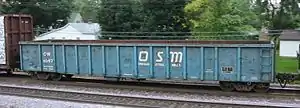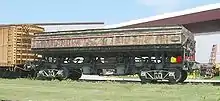Gondola (rail)
In US railroad terminology, a gondola is an open-topped rail vehicle used for transporting loose bulk materials. Because of their low side walls, gondolas are also suitable for the carriage of such high-density cargos as steel plates or coils, or of bulky items such as prefabricated sections of rail track.

History
Before the opening of the Baltimore & Ohio Railroad and the Chesapeake & Ohio Canal in Harpers Ferry, Virginia (now West Virginia), considerable amounts of coal were carried via the Potomac River. Since timber was an abundant resource, flat boats, called "gondolas" (a spoof on Venetian rowing boats), were constructed to navigate the "black diamonds" downriver to markets around Washington, DC. There, both the boat and cargo were sold and the boatmen returned home by foot. The railroad cars first employed in the haulage of coal were thus named after these shallow-draft boats called "gondola cars".
Early gondola cars typically had low sides. Their contents had to be shoveled out by hand, and they took a long time to unload. In 1905, the Ralston Steel Car Company patented a flat-bottom gondola with lever-operated chutes that allowed the gondola to be unloaded automatically from the bottom. The chutes would direct the contents of the gondola to the sides. This coincided with the switch from wood to steel freight cars, as the pulling force of locomotives tended to crush the older wood cars.
Specialized car types
Gondolas as open observation cars

Open observation gondolas are gondolas changed into open observation cars
"Bathtub" gondolas

In the second half of the 20th century, coal haulage shifted from open hopper cars to high-sided gondolas. Using a gondola, the railroads are able to haul a larger amount of coal per car since gondolas do not include the equipment needed for unloading. However, since these cars do not have hatches for unloading the products shipped in them, railroads must use rotary car dumpers (mechanisms that hold a car against a short section of track as the car and track are slowly rotated upside down to empty the car) or other means to empty them. The term "bathtub" refers to the shape of the car.
The "Double Rotary" coal gondola is required in this consist. The "Double Rotary" referring to this car that has rotary couplers on both ends instead of one end.
There are different types of "bathtub" coal gondolas. Those with one single symmetrical tub (i.e. Berwick Bathtubs & ACF Coalveyors) & Those with two symmetrical tubs (i.e. BethGon Coalporters).
Track ballast gondolas

Track ballast gondolas carry ballast. These gondolas are side tipping.
Lorry or mine car

An open railroad car (gondola) with a tipping trough, often found in mines. Known in the UK as a tippler or chaldron wagon[1] and in the US as a mine car.[2]
Chaldrons

The first railway bulk-cargo gondolas, the first freight wagons, were the chaldron cars of the early coal-carrying plateways. These were relatively short in length and tall in proportion, with a tapered body that widened upwards, above the wheels. Once locomotive haulage began, the unstable and top-heavy nature of this design became a problem with increasing speeds and later wagons became lower and longer. The chaldron shape survived in a few cases, such as low-speed working around a large factory sites including steelworks.
Naming
- In Australia these wagons are called open wagons.
See also
References
- Chaldron wagon Archived 2008-12-08 at the Wayback Machine
- "30-Cu. Ft. Mine car". Archived from the original on 2011-07-17. Retrieved 2010-10-13.
- doublestackinter Archived May 18, 2006, at the Wayback Machine
- Origin of name Archived October 7, 2007, at the Wayback Machine
External links
- Atchison, Topeka and Santa Fe Railway #72312 – photos and short history of an example of a typical steel, four-axle, solid bottom, fixed end, mill gondola.
- Guide to Rail Cars
- Rail car manufacturing
- Flexiwaggon
- Flexiwaggon, corporate website